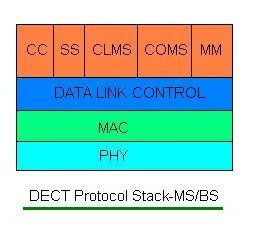DECT Tutorial
This DECT Tutorial covers DECT system basics, DECT system specifications, DECT frame structure and DECT protocol stack.
The system was developed in 1993 to provide service to domestic and corporate users. It supports both CS(Circuit switched) voice and data services. It is like GSM cellular system but the difference between them is GSM cells are large in size while DECT cells are smaller in size. It can be interfaced by PBXs.
DECT system basics
DECT stands for Digital Enhanced Cordless Telecommunications. Cordless telephony concept was originally introduced to provide mobility within home or office from main telephone terminal using a device called handset. Handset and main base terminal telephone unit is connected via a analog wireless link.
Distance coverage for DECT based system is between about 30-100 meters. It operates at about 1.88GHz to 1.9GHz Radio frequency carrier band, providing a bandwidth of about 20MHz. The access technology for resource allocation here is TDD/TDMA/FDMA. For know more on TDD,TDMA and FDMA refer following links. Data transmission rate of about 1.152 Mbps is achieved.
DECT system specifications or features
Following are the features of DECT system.
| Specification or Feature |
DECT system support |
|---|---|
| RF Carrier frequency | 1.88 to 1.9GHz |
| Access | TDD/TDMA/FDMA |
| Cell radius | 25 to 100 meters |
| Channel Spacing | 1.728 MHz |
| No. of carriers | 10 |
| No. of channels per carrier | 12 |
| Speech codec | ADPCM with 32kbps speech rate |
| Modulation techniques supported in DECT | Gaussian, FSK, 4PSK, 8PSK, 16-QAM, 64-QAM |
| Bit rate | 32 Kbps |
| Time slots | 2 x 12 ( upstream, downstream) |
| Channel Allocation Method | Dynamic |
| Traffic density | 10000 Erlangs/Km2 |
DECT Frame Structure

DECT frame duration is about 10ms. It is composed of 24 time slots. 12 time slots are allocated for base terminal to handset direction and 12 logical time slots are allocated for handset to base terminal direction.Each time slot is of duration 0.417ms.
One Time slot = preamble(16bits) + sync(16bits) + A field(64 bits) + B field(320 bits) + X field(4 bits) + Guard bits(60bits)
A filed = Header(8 bits) + Data(40 bits) + CRC(16 bits)
B field= Data(64bits) +CRC(16 bits) +Data + CRC+Data +CRC +Data +CRC
Sync field is used by receiver to synchronize with the start of the frame. A field carries control or management signals. B field carries user data/information. The figure-1 depicts the DECT frame structure as explained.
DECT protocol stack

Protocol stack of DECT depicted in figure is used both at Mobile unit and Base Station Unit.
It consists of Physical layer, MAC, Data link control layer and different services.
Services include CC (Call Control), Supplementary services,C onnection less message service,
connection oriented message service and MM(Mobility Management).
DECT MAC layer controls the layer-1(i.e. physical layer). It also provides connection oriented, connectionless and broadcast services to the upper layer in DECT protocol stack. It also provides encryption functionality with the use of Standard cipher protocol.
DECT ULE (Ultra Low Energy)
DECT ULE is the latest standard upgradation of legacy DECT standard described above.
It supports many additional features which were not available/supported by DECT standard.
It supports low power consumption and delivers long range compare to DECT.
It supports moderate data rate and lower latency based applications.
Refer DECT ULE tutorial➤ and DECT vs DECT-ULE➤
for more information.
Useful Links
DECT system overview and Standards can be downloaded from following link:
https://www.etsi.org/technologies-clusters/technologies/dect
Difference between TDD and FDD
TDMA-This page covers TDMA basics,types of TDMA and mention disadvantages.
FDMA-versus-TDMA-versus-CDMA-This page covers comparison between FDMA,TDMA and CDMA access techniques.
FDM-versus-TDM-This page covers compares FDM and TDM multiplexing techniques.
IoT Wireless Technologies
➤WLAN
➤THREAD
➤EnOcean
➤LoRa
➤SIGFOX
➤WHDI
➤Zigbee
➤6LoWPAN
➤Zigbee RF4CE
➤Z-Wave
➤NFC
➤RFID
➤INSTEON
